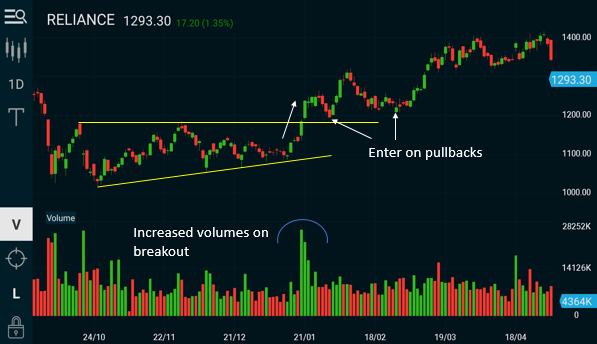If you’ve never heard about breakouts, you must be thinking this is a masterclass on how to get out jail. Well you’re close.
So, What Is a Breakout?
A breakout is nothing but a stock moving out of a jailed zone between its previous support or resistance level with increased volume. A breakout trader usually enters a long position after the stock price breaks above resistance or enters a short position after the stock breaks below support.

When it comes to the markets, breakouts is an extremely popular method used by many traders. Whether you use intraday, daily or weekly charts, breakouts are a great strategy, as the concepts can be applied universally.
Why breakouts?
There are clear advantages of this strategy, like:
- Breakouts are a starting point for major price trends.
- One can take a position in the early stages of the trend.
- It is also denotes an increase in volatility, which can help options traders create strategies and
- limited downside risk

Points to Ponder
Before we dive deeper, here are some important pointers you must remember if you want to trade breakouts successfully:
- A breakout occurs after a stock has stayed in a trading range for a long period of time. Whether you’re looking at a stock in a channel (Fig 2) or between horizontal supports and resistances (Fig 3), the greater the number of previous touches, the stronger the breakouts.
- The stock should have traded on lower volumes in the range.
- The breakout must occur on strong volume - at least two times higher than the 20 day vol SMA - to be considered valid.
- The breakout should be a clear pattern like channels, rectangles, triangles etc. and preferably in sync with the general market trend.
- If the stock has broken through a support or resistance by a big gap, it would be preferable to wait for a pullback and not chase the stock. The risk to reward in such trades could be against you in such trades.
- As a trader, you must exercise patience and refrain from entering these trades too early in anticipation of the breakout.
Fig 2 : Infosys breaks out of consolidation after 3 months in a downward channel

Fig 3 : Reliance breaks out of resistance line after 4 months of consolidation

Challenges of Breakout Trading
The biggest downfall with breakout trading is that there are too many false breakouts. Many breakouts are also not decisive as the market may enter another consolidation zone. Happens when the breakout lacks strength. An even more difficult scenario for a trader is when the market breaks out in one direction, only to quickly reverse and break out with greater force in the opposite side. In such cases, the trader should stop and reverse, but most lack the courage to do so.
Scanner for Breakouts
You can avoid several pitfalls by using a Scanner to detect breakouts. Scanner is the perfect tool where you can preset all your conditions and let the machine do the hard work for you. This can make your job much easier as you now have a smaller number of charts to analyse and pick your trades. The Market Pulse Scanner has several scans you can easily execute that will help you shortlist stocks.
More coming your way, next week we will cover - Price Volume Breakouts
